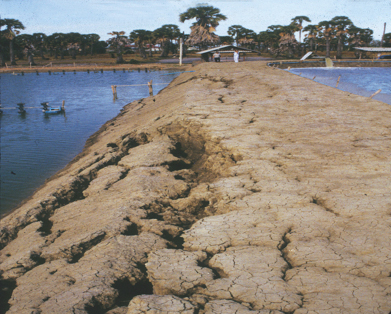
Responsibility
A comparison of resource use in shrimp farming, part 3: Energy
In part three of this series, the authors say lower energy use in shrimp farming requires producers to focus on water exchange and aeration.
Health & Welfare
Demand for dissolved oxygen is high in modern, intensive aquaculture, so DO concentration must be continuously maintained by mechanical aeration.

Responsibility
In part three of this series, the authors say lower energy use in shrimp farming requires producers to focus on water exchange and aeration.

Health & Welfare
Evaluating three aeration systems showed that air-injector nozzles produced greater microorganism diversity, biofloc development, overall shrimp productivity.

Responsibility
Prof. Boyd writes that his calculations suggest that the efficiency of shrimp pond aeration could be improved with internal combustion engines and drive trains.

Responsibility
Prof. Boyd discusses energy use in aeration for aquaculture production systems, along with rates, types of aerators, motors and electricity generation.

Intelligence
In this second of two parts, the author describes a public-private competitive improvement plan and how technology and new tools improved shrimp production in Ecuador.

Health & Welfare
Bubble size is a critical parameter in diffused bubble, aquaculture aeration systems. This study was conducted to determine the influence of water with different salinities on performance of nanobubble generating technology (NBT).

Health & Welfare
The summer season poses threats for oyster aquaculture worldwide. In addition to high mortality, poor oyster quality and health – especially in enclosed bays – are often attributed to water stratification, high temperatures and hypoxia.

Responsibility
While intensive shrimp farms in Australia and elsewhere are sensitive to rising energy prices, global intensification and farming innovations have led to significant improvements in shrimp farm energy efficiency. Important among the changes was the global switch to zero-exchange production of white shrimp.

Responsibility
The amount of aeration can be increased as feeding rate increases to conserve energy. Aeration in shrimp ponds usually can be reduced from mid-morning until early evening. Research has demonstrated that considerable energy can be saved by using aerator automation systems.

Health & Welfare
The potential shrimp aquaculture has for significant improvements in performance through improved genetics and nutrition will not be fully expressed unless appropriate feeding methods are practiced.

Health & Welfare
Although Bali is primarily a tourist destination, several small family-owned shrimp farms are located here. The Ndaru Luat Setio shrimp farm at Kubu raises specific pathogen-free Litopenaeus vannamei in ponds that apply basic biofloc technology with zero water exchange.

Responsibility
A carbon footprint is an estimate of the total carbon emissions resulting from the production, use and disposal of a product or service. Carbon footprints for aquaculture products result mainly from the use of manufactured feed and mechanical aeration.

Health & Welfare
The ideal pH for most aquaculture species is between 6.0 and 8.5. Lower pH values may result in decreased growth and survival, and greater susceptibility to disease. pH typically is lowest in the early morning, increases during the afternoon and declines at night.

Responsibility
The control of external inputs of suspended soil particles to ponds and internal erosion of embankments and bottoms should begin at the design and construction stage.

Responsibility
Water temperature is a key water quality variable in aquaculture because it influences other variables, defines growing seasons and dictates what species can be grown at a particular location.